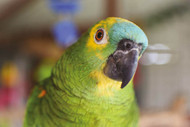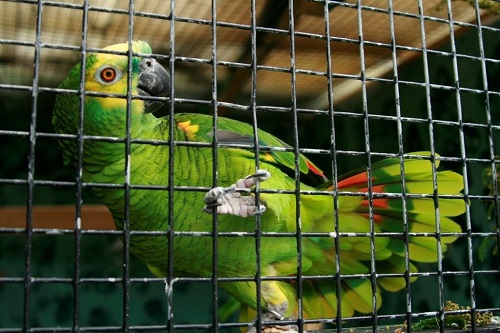Blue-fronted Amazon Fact Sheet
Posted by Blue-Fronted Amazon facts, Blue-Fronted Amazon diet, Blue-Fronted Amazon breeding on 9/1/2024
Rosemary Low explains more about the Blue-fronted Amazon in her fact sheet.
Scientific name:
Amazona aestiva
Common name:
Called Turquoise-fronted Parrot in the ornithological literature.
Adult length:
14-15in (35-37cm).
Adult weight:
375-500g.
Potential lifespan:
55 years.
Click here for everything you need for Blue-fronted Amazons.
Origin:
Brazil, Paraguay and northern Argentina.

Suitability
Blue-fronts are vivacious, loquacious and very handsome. They have much more personality than ?er, no! I must not antagonise keepers of other species! I love them! However, there is a big BUT. Adult males often lose their homes because when they mature they can become very aggressive and bite very hard, even flying at a person?s face.
Inexperienced Amazon owners who want a companion in the home should buy only a young DNA-sexed female. Whether male or female, regular supervised periods outside the cage should be limited to no more than one or two hours at a time. Longer periods result in Amazons believing they own the place and attacking ?intruders? when they are in breeding condition.
Identification
The head coloration of this species is extremely variable. I recently visited a breeder who almost stunned me into silence by telling me that his Blue-fronted Amazons were Orange-wings! He believed this because they had little blue on the head.
Note that even chicks can be distinguished before they have any feathers.
Blue-fronts have black beaks! The plumage varies greatly according to the location in South American from which they originate.
Diet
Fruit, vegetables and cooked or soaked pulses (beans and peas) should comprise at least 40% of the diet. The rest should consist of a good quality seed mixture (with limited amounts of sunflower and preferably the peanuts removed for the wild birds) or perhaps pellets that do not contain artificial colours or flavouring.
As with all Parrots, items of fresh food high in Vitamin A should be favoured. These include par-boiled carrot, red bell pepper (cooked or raw), broccoli and cooked sweet potato.
Whole young plants of dandelion and sow thistle are very valuable from spring to autumn and seeding dock is excellent during summer and early autumn. Hawthorn berries will be relished. Items from the table such as meat bones (with no sharp edges) and cooked potato are often relished, also cubes of hard cheese. Bones and cheese provide some calcium.
Click here for Amazon Parrot food.
Cages
A Blue-fronted Amazon will not be happy in a small cages. Close confinement can lead to aggressive behaviour. Either buy the largest cage you can afford or construct an oblong cage from 12g welded mesh. Make sure that the design allows food and water pots (four in all) to be serviced without a hand entering the cage.
Adult males in breeding condition can be dangerous.
Click here for Blue-fronted Amazon cages.
Training
It is very important that basic commands such as ?Step up!?, ?Step down? and ?Fly off!? are taught at an early age ? the earlier the better. Blue-fronts can be very strong-willed! These instructions should be reinforced on a daily basis.
Teaching to Imitate
Unlike Grey Parrots, for example, a Blue-fronted Amazon can start to mimic at a very young age. Start with simple phrases such as ?Come on!? Say ?Bye-bye? only when you are going out and the Amazon will soon understand its meaning. The Blue-front can become one of the most talented mimics in the Parrot world.
Plumage Care
Misting with a plant sprayer will cause an Amazon to ruffle its feathers and spread its wings in ecstasy, chortling or screaming with enjoyment. Heavy spraying will be enjoyed by older birds or access to an aviary where rain-bathing can occur.
Wing-Clipping
Please don?t do it. I am not going to repeat this message in every article. (See Grey Parrot article for some valid reasons.)
Illegal Trade
This Amazon?s popularity, due to its ability to mimic and its beautiful plumage, means that removal of young from nests continues on an alarming scale.
As an example, on September 19 2008, 225 Amazons Parrot chicks that had been hidden in boxes of vegetables were seized by police in the Pantanal region of Brazil after they received an anonymous call. All but 16 were Blue-fronted.
They were taken to a wild animal rehabilitation centre (CRAS) which then had a total of 400 confiscated chicks from that season?s nests. Although the chicks? eyes were open or just opening (two to three weeks old), they looked stunted at the time of seizure.
Sadly, 53 died soon after. This theft of young and adults from the wild has been illegal in Brazil for decades but continues not only to supply the domestic demand but probably also helps to supply the trade in wild-caught Blue-fronted Amazons in Argentina which is still legal. Captive-bred young are available in the UK. Make sure you obtain closed-ringed young birds from a breeder.
Breeding
I would appeal to breeders to pair together the same sub-species. (For descriptions and photographs see my book Amazon Parrots, Aviculture, trade and conservation.) These Amazons nest readily in the right circumstances (good diet, suitable accommodation and compatible pair). The problem lies in acquiring a female.
If you have a breeding pair please treat your female like gold dust. Ensure that she has the necessary calcium in her diet ( lay properly formed eggs. Every year female Blue-fronts die from egg-binding due to neglect of this vitally important aspect.
The female lays three or four eggs ? usually in May in the UK. Young spend about eight weeks in the nest. If hand-reared they will probably be independent at 14 weeks. From this you can work out that young will be available around August or September.
?If you are offered young birds in say February, you will know they are last season?s young. Blue-fronted Amazons do not breed in winter in the UK.
Conservation
In 1997 Projecto Papagaio Verdadeiro commenced. Based at Caiman Lodge, its aim is to manage and conserve the Blue-fronted Amazons of the Pantanal and the cerrado (the term for dry woodland of small trees and shrubs amidst savannah). In that first year project members identified 27 nests and followed four young birds that had been fitted with radio transmitters.
For everything you need for Blue-fronted Amazons please click here.




